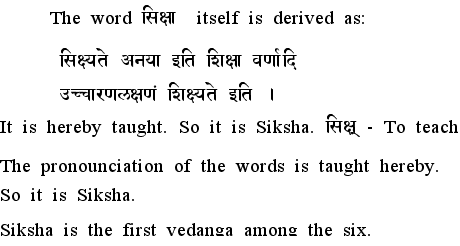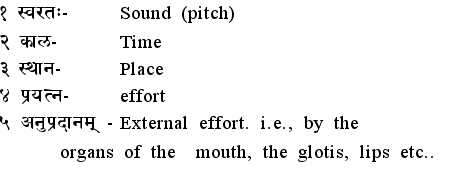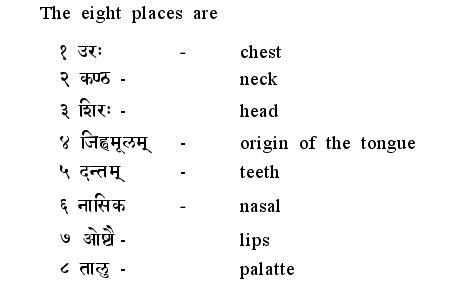Learn Sanskrit through Self Study
Lesson3: Conversation in a family
Section-15: Siksha- About Aksharas
As mentioned in our previous
article (Vedic approach to Sound), the Vedas are very particular about
the pronounciation of the aksharas and words. In order to pronounce a word
properly, it is not enough or sufficient to simply memorize and reproduce
the sounds. One must know the origin or the way sound originates, how it
interacts with other sounds and what is finally heard by the listner.

The Vedanga Siksha is also
based on Panini, the Vyakarana Kartha (exponent of the Vyakarana Shastra)
and explains the usage in worldly as well as in Vedic forms. The origin of sound as per
siksha is as follows.
The self communes with the
intellect and stirrs up the mind towards expressing the object. The mind
in turn, kindles the body heat which directs the wind through the regions
of the chest, first generates the low or mild form of the sound.
From here the wind proceeds
through the region of the neck to the head whence it comes out of the mouth
as the sound which we hear. In this process, five factors are recognized
in the production of the sound.

So the Siksha Shastra refers
to three types of sound volumes. Udatha, Anudatha and Swaritha, high, low
and medium respectively. Similarly, the sound can be differentiated on
the basis of time over which it is uttered, which can be, short, long or
very long. These are "hraswa", "dheerga" and "plutha". The Vedanga also
prescribes eight places (parts of the body) from where the sound gets accentuated.

The Siksha Shastra gives
the different aksharas which originate from the eight places and their
combinations. It also describes the times for the different individual
and combination aksharas.
A complete and thorough study
of the Vedas requires in depth knowledge of the Siksha Shastra. However,
for our purposes here, we will not require the intricate details of the
Shastra. This article was presented only to convince the student of the
thoroughness of the Vedic system of Instruction. It may be pertinent to
point out that the aksharas and their combinations can also be indicated
through signs or gestures using the fingers, somewhat similar to the manner
in which a maestro would conduct an orchestra. It is also possible to view
this as a basis for a form of sign language!
Next Section Glossary
Previous Section Summary
Start of this Lesson
|
Contents
Introduction
Early Morning
Later in the Morning
In the Afternoon
Later in the Evening
Basic Grammar
Imperative mood
Formation of sentences
Frame questions
Exercises-1
Exercises 2-3
Exercises 4-5
Exercises 6-7
Exercises 8-9
Summary
Siksha
Glossary
|














